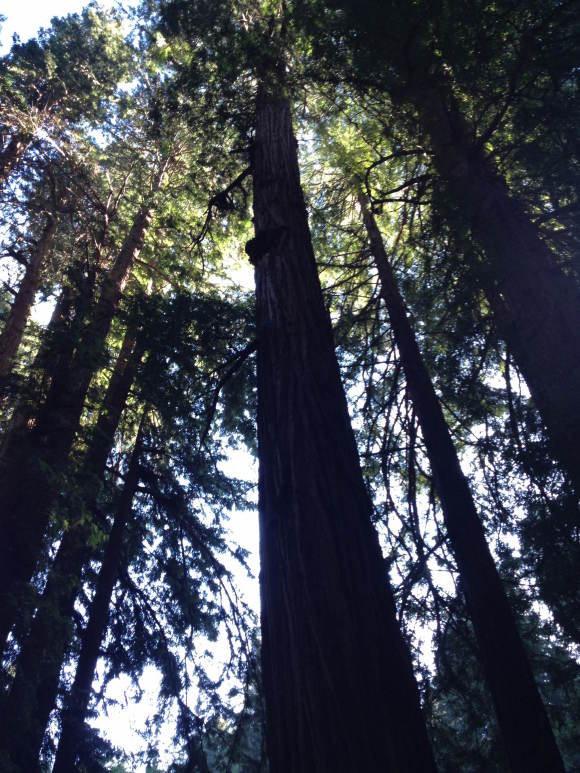“I’ve been here for five months now and I still say ‘wow!’ everyday”. That’s how Ranger Todd Hisaichi shared his feelings with a few dozen visitors the other day at the Muir Woods National Monument north of San Francisco. One of the last old-growth coastal redwood forests remaining, and in close proximity to the big city, Muir Woods provides easy access to some of the tallest trees in the world and a chance to practice yet another type of mindfulness, one described by Rabbi Abraham Joshua Heschel as “radical amazement”, or, as Ranger Todd would put it – “wow!”.
This helps me take a slightly different view one of the scenes from this week’s Torah reading. Jacob, after outsmarting his brother Esau twice for the blessings of their father Isaac, must flee for his life and leave Beer-Sheba for far away Haran, where his mother’s people live. Even if not stipulated in the narrative, it feels as if it’s his first night on the road, and that he’s just about to cross the imaginary border of the Promised Land into the unknown, when he stops for the night:
He had a dream; a stairway was set on the ground and its top reached to the sky, and angels of God were going up and down on it. And the Lord was standing beside him and said, “I am the Lord, the God of your father Abraham and the God of Isaac: the ground on which you are lying I will assign to you and to your offspring. Your descendants shall be as the dust of the earth; you shall spread out to the west and to the east, to the north and to the south. All the families of the earth shall bless themselves by you and your descendants. Remember, I am with you: I will protect you wherever you go and will bring you back to this land. I will not leave you until I have done what I have promised you.” Jacob awoke from his sleep and said, “Surely the Lord is present in this place, and I did not know it!” Shaken, he said, “How awesome is this place! This is none other than the abode of God, and that is the gateway to heaven.” (Gen. 11-17)
There are, of course, many different interpretations regarding the angels, what they were up to and their relationship with Jacob. Just as much has been written about the precise location where this all took place. However, I’d like to focus on the angels on the ladder itself, and as usual, through images of ritual objects while taking into consideration the purpose of those objects.
A very common way of imagining this ladder is similar to how it is depicted in this French Mizrah. Seeing that a Mizrah is connected to the daily prayer practice, indicating the proper direction of prayer, to the east toward Jerusalem – at least in lands lying west of the Holy Land – one might imagine that this image helped those praying to envision their prayers as climbing up a ladder toward the heavens.
Here is a close up of the center panel of this poster, showing the angels descending down the ladder from heaven. One might imagine that one praying with this image in mind is thinking about the blessings that descend from heaven, for which she is giving thanks:
On the other hand, many images show angels moving in both directions, which might symbolize a dynamic back and forth between the individual and the heavens – supplication and praise moving upward, blessing and protection coming down. This might be the case in this Italia amulet from the 19th century:
And here, the particular scene (lower left hand corner) enlarged:
If praying in the right direction and protection with the help of amulets are symbolized by Jacob’s ladder, for others, the study of Torah is the way we form and develop our relationship with God. Sometimes through the unmitigated reading of the Torah, from the scroll as part of the ritual reading in the synagogue. This yad, or Torah pointer, now in the American Jewish University, is from the collection of one of my father’s mentors, Seymour Newman:
Yet for others, only through the interpretations of the sages, is the Torah a relevant source of heavenly instruction, hence the appearance of this scene (lower right hand corner) of the title page of this Madras Rabbah, printed in Amsterdam in 1725:
What did Jacob’s ladder mean in the literary context in which it is found and what might it mean for us today? With the memories of giant redwood trees reaching into the heavens still fresh in my mind and the words of Ranger Todd, still echoing in my ears, I’m thinking that perhaps Jacob’s ladder was meant to “wow!” him. Here he was leaving his family, the promise of both land and progeny into what might be a spiritual desert for him. It seems like God just wants to assure him that God’s presence will be near and that messages from heaven will continue to reach his heart and soul. God doesn’t want Jacob to forget to say “wow!”.
It is for that reason that for me, at least this year, Jacob’s ladder would look a lot like this:
Shabbat Shalom and Happy Thanksgiving









